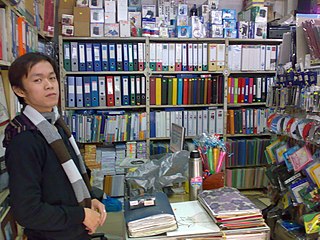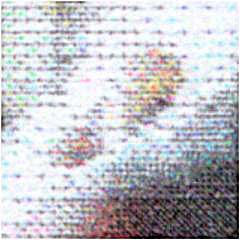
In computing, a printer is a peripheral device which makes a persistent representation of graphics or text, usually on paper. While most output is human-readable, bar code printers are an example of an expanded use for printers. The different types of printers include 3D printer, inkjet printer, laser printer, thermal printer, etc.
PostScript (PS) is a page description language in the electronic publishing and desktop publishing business. It is a dynamically typed, concatenative programming language and was created at Adobe Systems by John Warnock, Charles Geschke, Doug Brotz, Ed Taft and Bill Paxton from 1982 to 1984.

In computer graphics and digital photography, a raster graphics or bitmap image is a dot matrix data structure that represents a generally rectangular grid of pixels, viewable via a bitmapped display (monitor), paper, or other display medium. Raster images are stored in image files with varying dissemination, production, generation, and acquisition formats.

A line printer prints one entire line of text before advancing to another line. Most early line printers were impact printers.

Dot matrix printing, sometimes called impact matrix printing, is a computer printing process in which ink is applied to a surface using a relatively low-resolution dot matrix for layout. Dot matrix printers typically use a print head that moves back and forth or in an up-and-down motion on the page and prints by impact, striking an ink-soaked cloth ribbon against the paper, much like the print mechanism on a typewriter or line printer. However, a dot matrix printer is able to print arbitrary patterns and not just specific characters.
A line matrix printer is a computer printer that is a compromise between a line printer and a dot matrix printer. Basically, it prints a page-wide line of dots. It builds up a line of text by printing lines of dots.
A stored energy printer is a computer printer that uses the energy stored in a spring or magnetic field to push a hammer through a ribbon to print a dot. As compared to dot matrix printers that print a single column of dots at a time, this printer generally creates an entire line of dots at a time. Therefore, it is also known as a line matrix printer. This technology produces premium impact printers that print for millions to billions of dots per hammer. The advantage of this technology is that it has the lowest known cost of ownership: ink is transferred by conventional typewriter-style ribbons.

A dot matrix is a 2-dimensional patterned array, used to represent characters, symbols and images. Every type of modern technology uses dot matrices for display of information, including mobile phones, televisions, and printers. They are also used in textiles with sewing, knitting and weaving.

Daisy wheel printing is an impact printing technology invented in 1970 by Dr Andrew Gabor at Diablo Data Systems. It uses interchangeable pre-formed type elements, each with typically 96 glyphs, to generate high-quality output comparable to premium typewriters such as the IBM Selectric, but two to three times faster. Daisy wheel printing was used in electronic typewriters, word processors and computers from 1972. The daisy wheel is considered to be so named because of its resemblance to the daisy flower.
Centronics Data Computer Corporation was an American manufacturer of computer printers, now remembered primarily for the parallel interface that bears its name, the Centronics connector.

Stationery is a mass noun referring to commercially manufactured writing materials, including cut paper, envelopes, writing implements, continuous form paper, and other office supplies. Stationery includes materials to be written on by hand or by equipment For example: computer printers.

The ImageWriter is a product line of dot matrix printers formerly manufactured by Apple Computer, Inc., and designed then to be compatible with their entire line of computers. There were three different models introduced over time, which were popular mostly among Apple II and Macintosh owners.

Dots per inch is a measure of spatial printing, video or image scanner dot density, in particular the number of individual dots that can be placed in a line within the span of 1 inch (2.54 cm). Similarly, the more newly introduced dots per centimeter refers to the number of individual dots that can be placed within a line of 1 centimeter (≈ 0.393 in).

Thermal printing is a digital printing process which produces a printed image by selectively heating coated thermochromic paper, or thermal paper as it is commonly known, when the paper passes over the thermal print head. The coating turns black in the areas where it is heated, producing an image. Two-color direct thermal printers can print both black and an additional color by applying heat at two different temperatures.

A dot matrix printer is an impact printer that prints using a fixed number of pins or wires. Typically the pins or wires are arranged in one or several vertical columns. The pins strike an ink-coated ribbon and force contact between the ribbon and the paper, so that each pin makes a small dot on the paper. The combination of these dots forms a dot matrix image.
A computer font is implemented as a digital data file containing a set of graphically related glyphs, characters, or symbols such as dingbats. Although the term font first referred to a set of movable metal type pieces in one style and size, since the 1990s it is generally used to refer to a set of digital shapes in a single style, scalable to different sizes. A font family or typeface refers to the collection of related fonts across styles and sizes.
A letter-quality printer was a form of computer impact printer that was able to print with the quality typically expected from a business typewriter such as an IBM Selectric.
ESC/P, short for Epson Standard Code for Printers and sometimes styled Escape/P, is a printer control language developed by Epson to control computer printers. It was mainly used in dot matrix printers and some inkjet printers, and is still widely used in many receipt thermal printers. During the era of dot matrix printers, it was also used by other manufacturers, sometimes in modified form. At the time, it was a popular mechanism to add formatting to printed text, and was widely supported in software.

Continuous stationery (UK) or continuous form paper (US) is paper which is designed for use with dot-matrix and line printers with appropriate paper-feed mechanisms. Other names include fan-fold paper, sprocket-feed paper, burst paper, lineflow, tractor-feed paper, and pin-feed paper. It can be single-ply or multi-ply, often described as multipart stationery or forms. Continuous stationery is often used when the final print medium is less critical in terms of the appearance at the edges, and when continuously connected individual sheets are not inconvenient for the application. Individual sheets can be separated at the perforation, and sheets also have edges with punched holes, which also can be removed at the perforation.
Near letter-quality (NLQ) printing is a process where dot matrix printers produce high-quality text by using multiple passes to produce higher dot density. The tradeoff for the improved print quality is reduced printing speed. Software can also be used to produce this effect. The term was coined in the 1980s to distinguish NLQ printing from true letter-quality printing, as produced by a printer based on traditional typewriter technology such as a daisy wheel, or by a laser printer.











